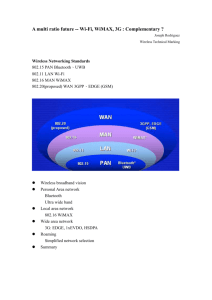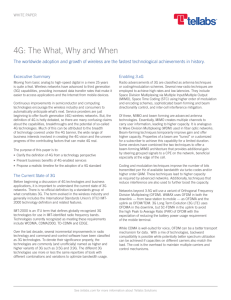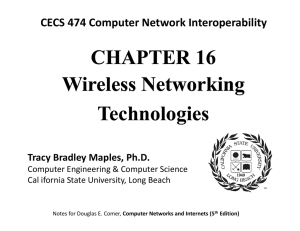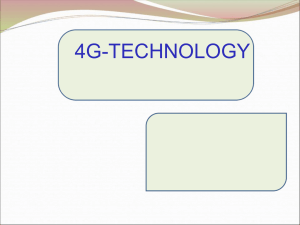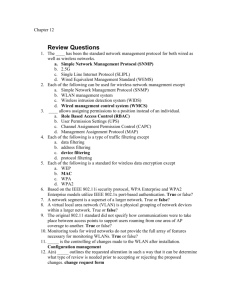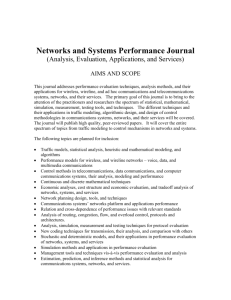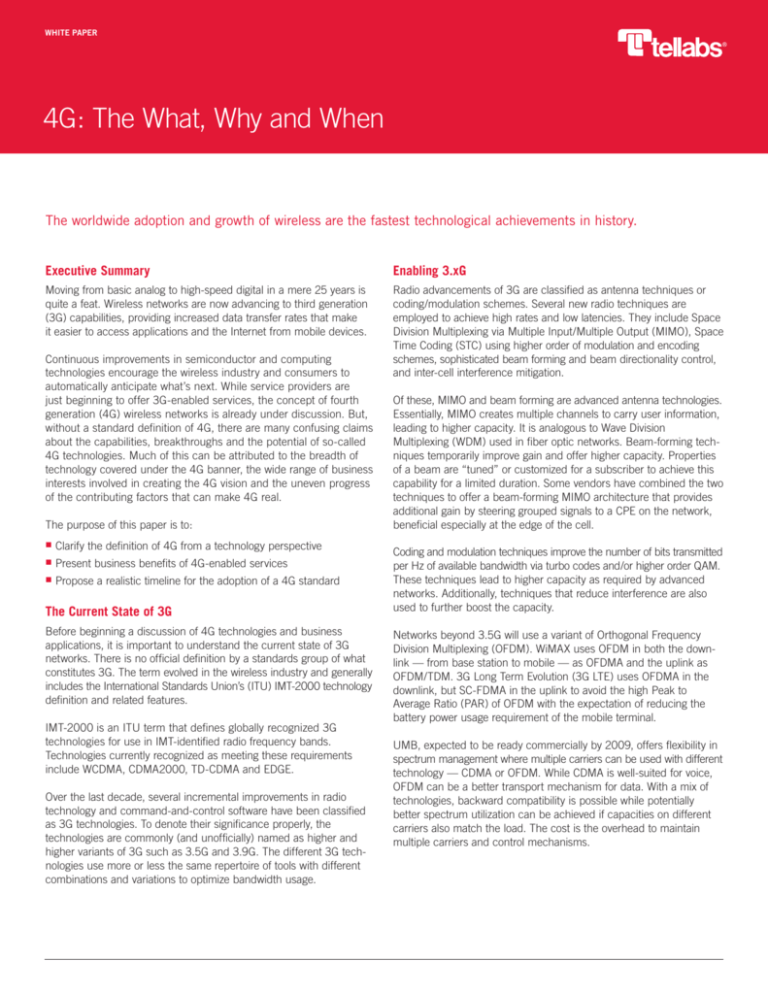
WHITE PAPER
4G: The What, Why and When
The worldwide adoption and growth of wireless are the fastest technological achievements in history.
Executive Summary
Enabling 3.xG
Moving from basic analog to high-speed digital in a mere 25 years is
quite a feat. Wireless networks are now advancing to third generation
(3G) capabilities, providing increased data transfer rates that make
it easier to access applications and the Internet from mobile devices.
Radio advancements of 3G are classified as antenna techniques or
coding/modulation schemes. Several new radio techniques are
employed to achieve high rates and low latencies. They include Space
Division Multiplexing via Multiple Input/Multiple Output (MIMO), Space
Time Coding (STC) using higher order of modulation and encoding
schemes, sophisticated beam forming and beam directionality control,
and inter-cell interference mitigation.
Continuous improvements in semiconductor and computing
technologies encourage the wireless industry and consumers to
automatically anticipate what’s next. While service providers are
just beginning to offer 3G-enabled services, the concept of fourth
generation (4G) wireless networks is already under discussion. But,
without a standard definition of 4G, there are many confusing claims
about the capabilities, breakthroughs and the potential of so-called
4G technologies. Much of this can be attributed to the breadth of
technology covered under the 4G banner, the wide range of business
interests involved in creating the 4G vision and the uneven progress
of the contributing factors that can make 4G real.
The purpose of this paper is to:
Clarify the definition of 4G from a technology perspective
Present business benefits of 4G-enabled services
Propose a realistic timeline for the adoption of a 4G standard
The Current State of 3G
Before beginning a discussion of 4G technologies and business
applications, it is important to understand the current state of 3G
networks. There is no official definition by a standards group of what
constitutes 3G. The term evolved in the wireless industry and generally
includes the International Standards Union’s (ITU) IMT-2000 technology
definition and related features.
IMT-2000 is an ITU term that defines globally recognized 3G
technologies for use in IMT-identified radio frequency bands.
Technologies currently recognized as meeting these requirements
include WCDMA, CDMA2000, TD-CDMA and EDGE.
Over the last decade, several incremental improvements in radio
technology and command-and-control software have been classified
as 3G technologies. To denote their significance properly, the
technologies are commonly (and unofficially) named as higher and
higher variants of 3G such as 3.5G and 3.9G. The different 3G technologies use more or less the same repertoire of tools with different
combinations and variations to optimize bandwidth usage.
Of these, MIMO and beam forming are advanced antenna technologies.
Essentially, MIMO creates multiple channels to carry user information,
leading to higher capacity. It is analogous to Wave Division
Multiplexing (WDM) used in fiber optic networks. Beam-forming techniques temporarily improve gain and offer higher capacity. Properties
of a beam are “tuned” or customized for a subscriber to achieve this
capability for a limited duration. Some vendors have combined the two
techniques to offer a beam-forming MIMO architecture that provides
additional gain by steering grouped signals to a CPE on the network,
beneficial especially at the edge of the cell.
Coding and modulation techniques improve the number of bits transmitted
per Hz of available bandwidth via turbo codes and/or higher order QAM.
These techniques lead to higher capacity as required by advanced
networks. Additionally, techniques that reduce interference are also
used to further boost the capacity.
Networks beyond 3.5G will use a variant of Orthogonal Frequency
Division Multiplexing (OFDM). WiMAX uses OFDM in both the downlink — from base station to mobile — as OFDMA and the uplink as
OFDM/TDM. 3G Long Term Evolution (3G LTE) uses OFDMA in the
downlink, but SC-FDMA in the uplink to avoid the high Peak to
Average Ratio (PAR) of OFDM with the expectation of reducing the
battery power usage requirement of the mobile terminal.
UMB, expected to be ready commercially by 2009, offers flexibility in
spectrum management where multiple carriers can be used with different
technology — CDMA or OFDM. While CDMA is well-suited for voice,
OFDM can be a better transport mechanism for data. With a mix of
technologies, backward compatibility is possible while potentially
better spectrum utilization can be achieved if capacities on different
carriers also match the load. The cost is the overhead to maintain
multiple carriers and control mechanisms.
2
WHITE PAPER — 4G: THE WHAT, WHY AND WHEN
2G
CDMA
(IS-95A)
GSM
2.5G
CDMA
(IS-95B)
GPRS
CDMA
2000
E-GPRS
EDGE
3G
3.5G
1xEV-DO
Rel 0/A/B
3.9G
UMB
802.20
TDMA
IS-136
IEEE
802.16
IEEE
802.1
802.11g
WCDMA
FDD/TDD
TD-SCDMA
LCR-TDD
HSDPA
FDD/TDD
HSUPA
FDD/TDD
LTE
E-UTRA
802.11a
Fixed WiMAX
802.16d
Mobile WiMAX
802.16e
HSPA+
WiBRO
802.11g
802.11n
Figure 1. Evolution to 3.9G
Figure 1 shows the path mobile networks will take as they evolve to
what is considered by many in the industry as 3.9G. When 3.9G is
deployed, a network-wide data rate of several hundred Mbps is
possible for the entire cell coverage area.
The CDMA standards use Multi-Carrier CDMA (MC-CDMA) along
with several other radio techniques to achieve up to 288 Mbps in the
downlink (base station to mobile subscriber) if and when Ultra Mobile
Broadband (UMB) is implemented. The UMTS standards (the evolution path for GSM) are expected to provide around 182 Mbps in the
downlink via HSPA+ technology. Mobile WiMAX, or 802.16e, is
expected to peak at a maximum of 79 Mbps.
Note that all data rates are for the entire cell coverage areas using at
least 20 MHz of bandwidth and include various overhead bits,
reducing the actual capacity available to mobile subscribers to a
lower value.
Definition of 4G: From the Source(s)
Currently, no industry group has a mandate to create a formal
definition of 4G. So, no technology can officially be classified as 4G.
This has resulted in some near term technologies such as WiMAX or
3G Long Term Evolution (LTE) being classified as 4G in some quarters.
The ITU IMT-A Standard
The ITU may emerge as the authority to define what constitutes 4G.
ITU’s IMT — Advanced (IMT-A) is a concept that intends to build on
the success of IMT-2000 as a benchmark for 3G. IMT-A systems are
envisioned to have capabilities surpassing those of IMT-2000 by
orders of magnitude.
IMT-2000-based 3G systems generally provide peak data rates of
around 1–5 Mbps. The IMT-A concept outlined in the ITU IMT-2000
document states:
“With the expectation that there will be a need for commercial
services in multi-user environments targeting peak data rates
approaching 100 Mbps for ‘highly mobile’ users, and up to
1 Gbps for nomadic (low mobility or stationery) users, the
IMT-A concept requires mandatory backward compatibility with
prior systems to match these high data rates.”
Highly mobile users are further defined as accessing the network at
speeds up to 125 KMph, while maintaining network connectivity at
speeds of up to 350 KMph. Data rates are not yet specified.
3G radio improvements are considered as IMT-2000 Enhanced.
Additional capabilities will also be available from an integrated network
under the IMT-A or 4G umbrella. Under 4G, access is not confined to
mobile users only, but is expanded to stationary or nomadic users just
as the network itself is not limited to Radio Access Networks (RANs),
but includes the whole: wireline access, wireless radio access, core
command, and control and back office functions in a unified system.
Figure 2 represents the ITU’s high-level view that delineates IMT-2000
and its Enhanced version versus what is to follow — IMT-A.
IMS Support
Support for mature IP Multimedia Systems (IMS)-based network is
another requirement to be considered in the definition of 4G.
Originally, concepts and specifications for IMS were developed by
the 3GPP group in cooperation with IETF to meet the needs of GSM
operators in providing IP-based services. With IP as the underlying
transport protocol, standardization relies on mature technologies and
the focus is shifted to what matters most to the subscribers and
operators: services. The IMS concept is further evolved to include the
complexities introduced by 4G networks.
WHITE PAPER — 4G: THE WHAT, WHY AND WHEN
A move to 4G should constitute a leap from 3.xG, not just another
incremental change in data rates. Given the goals of IMT-A, it is
appropriate to use this concept as the foundation for 4G to make
it more than just a slight step up from 3G. With this stipulation,
technologies delivering peak rates under 100 Mbps to a user could
not be considered 4G.
Human Requirements
Finally, how people use wireless networks is a consideration when
defining 4G. Table 1 summarizes the evolution of how the basic
senses of sound and sight — as well as knowledge — are fulfilled by
various generations of mobile wireless networks.
Systems beyond IMT-2000 will encompass
the capabilities of previous systems
New capabilities
of systems beyond
IMT-2000
High
New
Mobile
Access
IMT–2000
Mobility
3
Enhanced
IMT–2000
Enhancement
HUMAN
SENSE
NETWORK
GENERATION
SOUND
SIGHT
KNOWLEDGE
1G-2G
Voice
—
Low Speed Data
3G
Voice
Images
Hypertext (HT)
Voice, Speech
Video
Files (Speech,
HT, Video)
10–80 Kbps
1–20 Mbps
0.5–10 Mbps
<160 ms
<100 ms
<5 s
Communication
Entertainment
Information
4G
Typical
Bandwidth
Required
Latency
Principal
Application
Dashed line indicates
that the exact data
rates associated
with systems
beyond
IMT-2000 are
not yet
determined
New nomadic/
local area
wireless access
Low
1
Table 1. Mobile wireless generations and applications
Expanding 4G Beyond Wireless
Figure 3 shows the concept of a unified architecture employed by
the IMT-A network that is built on IP as the common transport layer
protocol. A rich interface regime fosters and facilitates new services
that enable the use of communication networks by devices yet-to-bedeveloped. With substantial improvements in access speeds, applications popular in the wireline world can be ported under the advanced
wireless networks in a uniform, seamless way so the participating
end users do not notice nor care how they access a service.
Developments on the Road to 4G
Some service providers and equipment manufacturers have already
staked claims to 4G service by providing mobile access rates above
3G’s 1–5 Mbps along with lower latencies. Rival camps claim services
with higher data rates under the banner of 3.5 or even 3.9G. But, just
improving access speeds alone should not qualify as 4G without an
entire suite of network-level integration.
The dilemma faced by 3G groups — 3GPP and 3GPP2 — is that they
cannot claim anything to be 4G under their 3G banner. The notion
of 3G LTE has been established for a number of years now. But,
technology developments outpace the reality of the standard-making
process.
10
100
1,000
Peak useful data rate (Mbps)
Figure 2. Boundaries of IMT systems
Today, 3G is deployed in most developed countries. 3GPP began
with the 2G GSM base to evolve via WCDMA as the core technology.
3GPP2 evolved from CDMA to CDMA2000. Both standards groups
promise comparable performance consistent with availability of radio
spectrum. Both have adopted OFDMA as the standard for at least the
downlink (base station to mobile user) direction and have further
promised to allow IP as the preferred packet format, beyond unique
MAC layers.
Networks based on 3G LTE are expected to be available by the 2010–
11 timeframe, allowing for a convenient entry for 4G in the
subsequent years. According to this schedule, there is no room for a
near-term 4G-network deployment. So what about WiMAX, the 4G
wannabe?
Where Does WiMAX Fit In?
Recently, ITU delegates declared WiMAX as an IMT-2000 technology.
The technology under consideration for inclusion in IMT-2000 is IPOFDMA. A specific variant of this technology is used by the IEEE
802.16e mobility standard, commonly referred to as WiMAX. As a
result, WiMAX now has gained the coveted status of a 3G technology.
While contradicting claims that WiMAX is a 4G technology, it
nevertheless is significant that the IEEE standards embedded in
WiMAX gain an official standard status from the ITU.
IEEE is pursuing a next-generation version of the technology embedded
in WiMAX under Study Group 802.16m. A stated goal of this study
group is to provide wireless data rates in excess of 100 mbps. This
technology is expected to reach standards status by 2009 and could
be a candidate for 4G.
4
WHITE PAPER — 4G: THE WHAT, WHY AND WHEN
Services and
applications
Download channel
New radio
interface
Digital
broadcast
Cellular
2nd generation
Packet-based
core network
Wireline
xDSL
RLAN
type
IMT-2000
Other entities
Short range
connectivity
Figure 3. Unified architecture for IMT-Advanced systems
While WiMAX (IEEE 802.16e) has gained acceptance globally as a
mobile broadband technology, its spectrum allocation is inconsistent.
As a result, is not fully recognized in some countries that would like
to follow ITU specifications strictly: China being a case in point. The
frequency of 2.5 GHz is included in the WiMAX standard as a valid
profile and authorized in the United States, Russia and the United
Kingdom, but is reserved by IMT-2000 for WCDMA in some other
countries.
Implementing 4G Services
When a standard definition of 4G is accepted, it will encompass all
existing generations of fixed and mobile wireless technologies with
major improvements in performance and capabilities. Fundamentally,
4G intends to alter the paradigm of user-network communication via a
single device connected to a (mostly) single network. Since 4G is
expected to be more than 3G phone service, it allows all sorts of
portable devices onto “the” network.
The Always Best Connected (ABC) character of 4G provides the
service with the most suitable network to a device. Embedding
broadband in all types of consumer devices is a goal of 4G. The
World Wireless Research Forum anticipates some 17 trillion devices
connected for seven billion people by the year 2017.1 If reality matches
that scale, 4G will do for portable consumer devices what 3G is
predicted to do for individual phones and laptops in terms of advances in
connectivity and productivity.
There are four access layers:
Fixed (i.e., DSL, cable, fiber) — fixed wireline networks
Personal (i.e., Bluetooth, UWB) — cars, cell phones, PDAs
Hot-spot (i.e., Wi-Fi/802.11) — restaurants, coffee shops, planes
Cellular (i.e., UMTS, WiMAX) — highly-mobile users
The standards groups covering existing technologies mentioned above
are working on the next-generation versions, which include higher
speeds and more advanced network integration and enablement for
service offerings.
Interactions among networks are not limited to horizontal (intra
network) or vertical (inter network) handoffs for service continuity,
but encompass complex functions of billing, security, privacy, Quality
of Service (QoS), network resilience, fault location and recovery to
provide a “seamless” experience to the user. This vision essentially
eliminates the need for the user to know anything about the network
(operator, topology, radio or other technology), and requires a lot of
heavy lifting by the networks to make it a reality.
Key Attributes of 4G
Based on the requirements for seamless interaction between
networks, 4G is characterized by the following key attributes:
Figure 4, published by the ITU, depicts the IMT-A vision of various
access systems (“networks”) interconnected to provide services in a
cooperating manner. To achieve this vision, ITU defines layers of
network based on the geographic scope of coverage and extent of
mobility offered by each layer.
1
System Concept and Requirements for the Future Wireless World: The WWRF View, January 2006.
Support for Multiple Applications and Services — Efficient
support for unicast, multicast and broadcast services and the
applications that rely on them. Prompt enforcement of Service
Level Agreements (SLA) along with privacy and other security
features. Minimally, service classes include delay sensitive, loss
sensitive, delay and loss sensitive and best effort.
5
WHITE PAPER — 4G: THE WHAT, WHY AND WHEN
Illustration of complementary access systems
Distribution
layer
– Full coverage
– Global access
– Full mobility
– Not necessarily individual links
Cellular
layer
Horizontal:
handover within
a system
– Full coverage and hot spots
– Global roaming
– Full mobility
– Individual links
Hot spot
layer
– Local coverage
– Hot spots
– Global roaming
– Local mobility
– Individual links
Personal network
layer
Vertical:
handover between
systems
– Short range communication
– Global roaming
– Individual links
Fixed (wired)
layer
Possible
return
channels
– Personal mobility
– Global access
Figure 4. ITU’s vision of IMT-Advanced providing service continuity
Quality of Service — Consistent application of admission control
and scheduling algorithms regardless of underlying infrastructure
and operator diversity.
Network Detection and Network Selection — A mobile terminal
that features multiple radio technologies or possibly uses softwaredefined radios if economical, allows participation in multiple
networks simultaneously, thereby connecting to the best network
with the most appropriate service parameters (cost, QoS and
capacity among others) for the application. This requires establishing
a uniform process for defining eligibility of a terminal to attach to a
network and to determine the validity of link layer configuration.
Seamless Handover and Service Continuity — A “base station”
that features intra- and inter-technology handovers, assuring service
continuity with zero or minimal interruption, without a noticeable
loss in service quality. Support for this function requires continuous
transparent maintenance of active service instances and inclusion
of various access technologies, from WiFi to OFDMA.
Technology and Topology Independence — Service capabilities to
transcend generations of technologies. Services not constrained by
topology or technology limitations, but rather achieve the “Always
Best Connected” characteristic.
If a financially sound business model evolves to support the 4G vision,
how do service providers and vendors evolve in a timely manner to
foster its existence and growth?
What can the user community do with it?
What are the costs?
Is the cost low enough to make it attractive to users?
Can usage patterns encourage application developers to continue
to innovate?
The short answer to the “Why 4G?” question is not why, but when.
There are several factors to consider:
Business Need and Opportunity — 3G operators are learning that
future average revenue per user (ARPU) does not come from
traditional service like voice and allied products (like ring tones).
Rather, data services such as mobile, video, music, games, Internet
access, navigation and messaging (SMS and MMS) are the path
to greater revenue. The trend is unmistakable and leads to more
services that exploit infrastructure offered by advanced technology.
Technology Pull — As Figure 5 shows, the key processor and
component semiconductor technology required to make progress
towards 4G is likely to reach economical levels as 4G comes to
fruition. Advances in power technology and radio receiver technology
are likely to converge with processor technology to make the
solutions viable.
Rate of Innovation — Adoption of application software that
combines media, location, user profiles and security fosters a
higher rate of innovation. This in turn hastens the march towards
solving the complex problems related to ubiquity via presence
technologies.
The Business Case for 4G
The vision of 4G is a framework for an advanced infrastructure
consisting of architecture, core technologies and open interfaces for
building, deploying and providing applications to achieve ubiquitous,
converged broadband services. 4G is much more than high access
speeds — it is a whole new “whole.”
Ubiquitous — any service at any place and any time via any
network to any person on any device
Converged — portability, seamlessness and continuity
Broadband — capacity-agnostic services
6
WHITE PAPER — 4G: THE WHAT, WHY AND WHEN
Bandwidth
Processor
10Kbps
8086
Technologies
AMPS
TACS
NMT
Generation
ANALOG
1G
50Kbps
RISC
GSM
TDMA
CDMA
GPU/NPU
GPRS
EDGE
IS-95B
DIGITAL
2G
1980s
CDMA2000
W-CDMA
UMTS
HSDPA
DIGITAL MULTIMEDIA
2.5G
1990s
1Mbps
3G
2000s
100Mbps
Multi-core (CMT)
and Virtualization
MC-CDMA
WiMAX
W-OFDM
MEDIA AND TV
4G
2010s
Figure 5. Evolution of processors and DSP technology for 4G
Disruptive Technologies — Always a wild card, new technologies
tend to accelerate the pace of growth and at times cause fragmentation. In the past, disruptions have steered the industry off a
planned path and actually slowed the pace of growth. The factors
behind disruptions such as technical talent, venture capital
financing and a willing buyer of the end product are very real.
A Realistic Timeline for 4G
Standardization — Use of a higher Layer Protocol (IP) as transport
medium affords intelligence at every stage within the network
relative to a service. IP’s unparalleled scalability can only be an
asset and its flexibility as a tool in forging a resilient and fault
tolerant infrastructure can help support functions such as security.
Standards in the area of Radio Technology such as affordable
Software Defined Radio (SDR) are likely to help as well.
New Revenue Opportunities — There is a growing cultural
acceptance of ad-based business models and entry-level service
packages for broadband. Tiered services with premium offerings
that include advanced features are also becoming popular. This
trend bodes well as a way to offset expensive infrastructure build-outs.
Developments in the Wireline World — Figure 6 shows projected
need for bandwidth for the next 25 years by the FTTH Council based
on high-definition video services. Compelling video experiences in
the wireline world put some pressure on the wireless video experience,
especially when near-field technologies such as Bluetooth, Wi-Fi
or UWB are available. Wireline developments have the potential to
drive the requirements for 4G applications, especially in the areas
of data and video.
3G Reaching Maturity and Profitability — 3G deployments began
as early as 2003 in some countries and by now, most advanced
countries have implemented some 3G networks with coverage in
excess of one billion subscribers. Today, 3G data services range
from 0.5 Mbps to 5 Mbps depending on the operator. Profitable
usage of data remains a challenge. Standard applications such as
Internet access are commonplace, although most operators apply
a maximum limit of 1–3 Gb of data transfer a month. It may take
2–3 years before current data pipes are saturated as usage patterns
evolve to take advantage of increased speeds. 3G operators worldwide are challenged by the returns on their investments. Only when
subscribers more fully embrace 3G services and operators realize
profitability will improvements to networks be considered.
Development and Deployment of IMS and Multiservice
Networking — As network integration with IMS progresses and
more applications suitable for the handheld screen become
available, demand for higher speeds increases. Concepts such as
dynamic resource management and admission control for policy
management need to reach maturity. IMS and non-IMS networks
need to interwork. Successful integration of IMS is an accelerator
of 4G; however, it will take longer than anticipated.
Based on the definition of 4G proposed in this paper, it will take
several years before “real 4G” is operational. There are many key
developments that affect the timeline for 4G that can either speed
up or slow down the process:
7
WHITE PAPER — 4G: THE WHAT, WHY AND WHEN
Validation of Radio Technologies — Several new technologies
improve access speeds: OFDMA, MIMO, beam forming and higher
order of modulation, among others. Some aspect of each of these
technologies need validation from a practical perspective. How well
the promise matches reality “on the ground” dictates the acceptance
rate of new services. For example, OFDMA requires more power on
handheld devices than is available today. Does that limit WiMAX for
use only on laptops? When can operators offer high-speed services
using these sophisticated techniques at price points acceptable to
end users?
Cost and Availability of Spectrum — This elephant in the room
transcends politics, regulation, capital and competition. The WWRF
projects a severe shortage of spectrum (of the order of tens to hundreds of GHz) to fulfill the vision of 4G. Cost of leased spectrum
figures in greatly in reaching profitability. For example, WiMAX is
experiencing some initial resistance from the investment community
in the United States, forcing operators to look for creative ways to
raise capital, including use of novel business models.
Issues Related to Content Ownership — Availability of content
is critical when new services rely on media from commercial
consolidators. With legalized P2P services coming to life, it may
be less critical.
Ecosystem Development — Development of applications, training
of support staff, creating smooth troubleshooting procedures are
asynchronous events. Timing of what becomes available when and
in what form is unpredictable. To be profitable, new technology
needs to scale, be cost competitive and not lose the focus on value
creation. It is impossible to assure that all of this can happen in a
synchronous manner.
With an ambitious definition of 4G, ITU speculates that standards and
technology will be available by 2012 and commercial services will take
hold in some countries by around 2015. Interestingly, since 4G is an
all-encompassing concept, it is not viewed as a singular technology as
has been the case with prior generations. With the merging of wireline
and wireless networks, services offered by operators are expected to
blur that distinction. So, the scope of 4G expands access to non-mobile
methods, wireless (such as IEEE 802.11 or WiFi) and wireline (such as
broadband cable, DSL and fiber).
Projected download bandwidth needed by a typical home
2030
28,799
8,892
3,118
2020
2,227
High
1,398
558
2010
Medium
113
53
23
1
10
Low
100
1,000
10,000
100,000
Figure 6. Wireline bandwidth demand projection for the next 25 years
Conclusion
There are many complex and interdependent moving parts that must
work together before a standard definition of 4G is solidified. The
benefits to service providers and end users drive the adoption of 3G
services that, in turn, lead to the demand for even more advanced
services. The realization of 4G tears down the wall between wireless
and wireline services, a challenging endeavor. Realistically, wide-scale
availability of 4G is several years away — somewhere in the middle of
the next decade.
North America
Asia Pacific
Europe, Middle East & Africa
Latin America & Caribbean
Tellabs
One Tellabs Center
1415 West Diehl Road
Naperville, IL 60563
U.S.A.
+1 630 798 8800
Fax: +1 630 798 2000
Tellabs
3 Anson Road
#14–01 Springleaf Tower
Singapore 079909
Republic of Singapore
+65 6215 6411
Fax: +65 6215 6422
Tellabs
Abbey Place
24–28 Easton Street
High Wycombe, Bucks
HP11 1NT
United Kingdom
+44 870 238 4700
Fax: +44 870 238 4851
Tellabs
1401 N.W. 136th Avenue
Suite 202
Sunrise, FL 33323
U.S.A.
+1 954 839 2800
Fax: +1 954 839 2828
Statements herein may contain projections or other forward-looking statements
regarding future events, products, features, technology and resulting commercial
or technological benefits and advantages. These statements are for discussion
purposes only, are subject to change and are not to be construed as instructions,
product specifications, guarantees or warranties. Actual results may differ materially.
The following trademarks and service marks are owned by Tellabs Operations,
Inc., or its affiliates in the United States and/or other countries: TELLABS®,
TELLABS and T symbol®, and T symbol®.
Any other company or product names may be trademarks of their respective companies.
© 2008 Tellabs. All rights reserved.
74.1948E Rev. A 4/08

